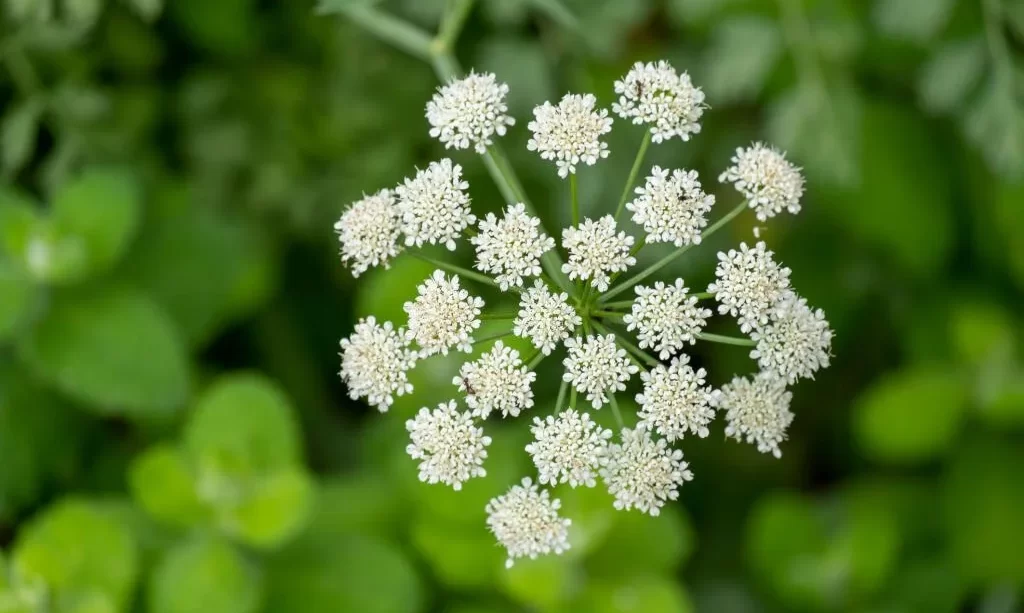Anise, with its aromatic and distinctive flavor, is a spice and herb that has left an indelible mark on culinary traditions worldwide. It is known for its licorice-like taste and sweet, fragrant aroma, making it a coveted ingredient in both sweet and savory dishes. Whether used in the creation of delightful desserts or as a subtle addition to savory recipes, anise is a flavor that adds depth and complexity to various culinary experiences.
- HARDINESS ZONE.4-10
- GROW.Plant the seeds about 1/4″ deep. They should germinate in about 10-21 days, once the soil temperature is around 65-70°F (21°C). Final plant spacing should be 6-12″ apart.
- WHEN TO PLANT.Anise seeds can be sowed directly outside after the danger of frost has passed.
- TALL.Anise is an herbaceous annual plant growing to 90 centimetres (3 feet) or more.
- USE.It is widely cultivated and used to flavor food, candy, and alcoholic drinks, especially around the Mediterranean.
Anise Overview
Anise, scientifically known as Pimpinella anisum, is a flowering plant native to the Eastern Mediterranean and Southwest Asia. This herbaceous plant bears small white flowers and produces seeds that are the source of anise’s distinct flavor. Throughout history, anise has held a significant place in cultural and culinary traditions, dating back to ancient Egypt and Greece, where it was believed to have medicinal and culinary properties.
Anise’s flavor profile is characterized by a remarkable combination of elements. Its primary taste is often likened to licorice, with a pronounced sweetness that carries subtle bitter undertones. This intriguing balance of flavors sets anise apart from other herbs and spices, making it a sought-after ingredient in the culinary world.
Anise’s aromatic qualities are equally captivating. The seeds and the essential oil extracted from them boast a strong, sweet, and inviting scent. This fragrant aroma is often harnessed in the creation of perfumes, liqueurs, and various herbal remedies.
In the following sections, we will delve deeper into the sensory experience of anise, exploring its flavor, aroma, and diverse culinary applications. Whether you’re a seasoned chef or a curious food enthusiast, understanding anise’s unique characteristics will open up a world of culinary possibilities and tantalizing tastes.
The Flavor Profile of Anise
Anise’s flavor profile is a harmonious blend of distinctive elements that contribute to its unique and captivating taste:
- Licorice-Like Taste: Anise is renowned for its licorice-like flavor, often described as reminiscent of black licorice candy. This taste is the hallmark of anise and sets it apart from other spices and herbs.
- Sweetness: One of the prominent aspects of anise’s flavor is its natural sweetness. The seeds contain compounds that impart a delightful, sugary note to dishes and beverages. This inherent sweetness can be enjoyed without the need for added sugar.
- Subtle Bitterness: Beneath its sweetness, anise carries subtle hints of bitterness. This bitter undertone adds complexity to its taste, providing a well-rounded and balanced flavor experience.
- Aromatic Complexity: Anise’s flavor extends beyond its initial taste, offering a multi-dimensional experience. Its aromatic complexity comes from the volatile compounds found in its seeds, which release their fragrant notes when used in cooking or infused in liquids.
- Mildness and Moderation: While anise has a bold and distinct taste, it is best used in moderation to avoid overpowering dishes. A little anise can go a long way in enhancing the overall flavor profile of a recipe.
Anise’s Scent and Aroma
Anise’s aromatic qualities are just as captivating as its taste, and its scent plays a significant role in culinary and sensory experiences:
- Sweet and Inviting Scent: The scent of anise is sweet, warm, and inviting. It carries a sense of comfort and nostalgia, often reminding people of the familiar aroma of licorice candy.
- Strong Fragrance: Anise seeds and their essential oil possess a strong and concentrated fragrance. When crushed or ground, the seeds release their aromatic compounds, filling the air with their sweet and appealing scent.
- Used in Perfumery: Due to its alluring aroma, anise finds its way into perfumery, where it contributes to the creation of fragrances that are both sweet and spicy, making it a valuable ingredient for perfumers seeking to craft complex scents.
- Aromatic Infusions: Anise’s aromatic qualities shine in infusions, such as herbal teas and flavored liqueurs. When steeped in hot water or alcohol, anise imparts its delightful scent and flavor to these beverages, creating soothing and enjoyable drinks.
Understanding the interplay between anise’s flavor and aroma is key to using it effectively in culinary creations. In the subsequent sections, we will explore the myriad ways anise can be used in global cuisine, from its role in classic recipes to its place in herbal remedies and traditional beverages.
Culinary Uses of Anise
Anise’s versatile flavor and enchanting aroma make it a prized ingredient in a wide range of culinary applications:
- Baking Delights: Anise is a star in the world of baking. It is commonly used to flavor anise cookies, biscotti, and pastries. Its sweet and aromatic notes infuse these treats with a delightful licorice-like taste.
- Desserts: Anise can be found in an array of sweet desserts, including anise-flavored ice creams, cakes, and puddings. Its unique flavor adds depth and character to these confections.
- Savory Dishes: Anise pairs wonderfully with savory recipes. It is often used in meat and poultry dishes, where its sweet and aromatic profile balances the savory elements. Anise is a key ingredient in dishes like braised fennel, sausages, and roasted meats.
- Flavoring Beverages: Anise’s aroma and flavor shine in beverages. It is a star ingredient in the production of liqueurs like ouzo, absinthe, and anise-flavored spirits. Anise seeds or pods are also used to infuse herbal teas, creating soothing and aromatic brews.
- Pickling and Preserves: Anise is sometimes added to pickling solutions and fruit preserves, enhancing their flavor with a touch of licorice-like sweetness. It pairs particularly well with pickled cucumbers and certain fruits.
Complementary Flavors and Pairings
Anise’s unique flavor can be accentuated when paired with complementary ingredients, creating harmonious and memorable taste experiences:
- Citrus: The bright and zesty notes of citrus fruits like oranges and lemons complement anise’s sweetness and add a refreshing contrast to its flavor.
- Cinnamon: Combining anise with cinnamon results in a warm and spiced flavor profile. This pairing is common in holiday desserts and spiced beverages.
- Fennel: Anise shares a close botanical relationship with fennel, and their flavors harmonize perfectly. Roasted fennel and anise is a classic combination, offering a double dose of licorice-like taste.
- Nuts and Seeds: Ingredients like almonds and sesame seeds work well with anise’s sweetness, creating a delightful contrast in both sweet and savory dishes.
- Herbs: Fresh herbs such as basil, mint, and tarragon can enhance anise-flavored dishes with their vibrant and aromatic qualities, creating a balanced and complex flavor profile.
- Chocolate: Anise’s sweet and aromatic notes can complement the rich bitterness of dark chocolate, offering a unique twist to chocolate desserts and confections.
Anise Varieties and Forms
Anise is available in various forms, each with its own characteristics and culinary uses:
- Whole Seeds: Anise seeds are the most common form, and they are often used in pickling, baking, and infusing beverages. They can be lightly toasted to intensify their flavor.
- Ground Anise: Ground anise is created by grinding anise seeds into a fine powder. It is convenient for baking and can be easily incorporated into recipes for a more uniform distribution of flavor.
- Anise Extract: Anise extract is a concentrated liquid derived from anise seeds. It is used to flavor various recipes, including cookies, cakes, and candies, with a small amount providing a significant burst of flavor.
- Star Anise: While not botanically related, star anise has a similar licorice-like taste and is often used in Asian cuisine. It is commonly found in soups, stews, and spice blends.
Understanding the diverse culinary uses of anise and its compatibility with other flavors empowers chefs and home cooks to experiment and create delightful dishes that showcase its sweet and aromatic qualities. In the following sections, we’ll explore how anise is celebrated in global cuisine and its role in herbal remedies and traditional beverages.
- ANISE SEED – Native to Mediterranea, Anise yields a flavorful seed of culinary and medicinal significance. Anise seed is a lovely addition to baked desserts and is commonly used for flavoring biscotti. White blossoms attract beneficial insects.
- EASY TO GROW, HARVEST, AND ENJOY – Perfect addition to your herb garden! Anise is an annual, and grows best from spring to summer in most climates. 120 days from seed to harvest. Packet contains a minimum of 125 seeds.
- SEEDS YOU CAN TRUST – Our seeds are non-GMO, heirloom, untreated, and open-pollinated. This makes sourcing seed from our company an easy and ethical choice.
- KNOW THE SOURCE, GROWN IN THE USA – Our company is located in Ojai, California. We take great pride in our plants and are dedicated to bringing you the best quality seeds for your garden.
- GREAT CARE, GREAT RESULTS – Our team is dedicated to bringing you only the best selection! We have spent years developing our expertise as seed specialists. Our seeds are tried and true, resulting in better germination rates and hardy harvests!
Anise in Global Cuisine
Anise’s allure extends across continents, and its presence in global cuisine is a testament to its versatility and adaptability:
- Mediterranean Delights: In Mediterranean cuisine, anise finds its way into both sweet and savory dishes. It is a key ingredient in Greek ouzo and arak, where it is traditionally diluted with water to create a refreshing anise-flavored beverage. Anise is also used in savory dishes like lamb tagines and roasted vegetables, where its sweet and aromatic notes provide depth of flavor.
- Middle Eastern Cuisine: Anise is a beloved spice in Middle Eastern cooking, particularly in the preparation of sweets. It is used to flavor desserts like baklava, ma’amoul (date-filled cookies), and basbousa (semolina cake). In savory dishes, anise pairs beautifully with meats, imparting its sweet and aromatic essence to kebabs and stews.
- Asian Influences: While star anise is more common in Asian cuisine, regular anise seeds still make appearances in various dishes. In Chinese cuisine, anise is an essential component of five-spice powder, adding its distinctive taste to stir-fries and braised dishes. In Indian cuisine, anise seeds may be found in spice blends and some curries.
- Latin American Flavors: Anise plays a role in Latin American cuisine, where it is used in both culinary and beverage traditions. In Mexico, anise is a key ingredient in the preparation of traditional sweet breads, such as conchas and rosca de reyes. It is also infused into aguas frescas (refreshing fruit-based beverages), providing a refreshing and aromatic twist to drinks.
Anise in Herbal Remedies
Beyond its culinary uses, anise has a historical presence in herbal remedies and natural healing practices:
- Digestive Aid: Anise has been employed for centuries as a digestive aid. It is believed to help alleviate digestive discomfort, including bloating and indigestion. Anise-infused herbal teas are a common remedy for soothing digestive issues.
- Respiratory Health: Anise is known for its potential benefits in promoting respiratory health. It is often used in herbal remedies to relieve coughs, congestion, and throat irritation. Anise’s soothing properties make it a popular addition to herbal cough syrups and lozenges.
- Menstrual Comfort: Anise is sometimes used to address menstrual discomfort and symptoms associated with PMS. It is believed to have mild estrogenic properties that may help regulate hormonal imbalances.
- Infusions and Tinctures: Anise is infused into herbal teas, tinctures, and decoctions to harness its potential medicinal benefits. These preparations are used to address specific health concerns or as natural remedies for common ailments.
Conclusion
Anise’s enchanting flavor and captivating aroma have made it a cherished ingredient in kitchens and apothecaries alike. Its licorice-like taste, sweet fragrance, and aromatic complexity have left an indelible mark on global cuisine and herbal remedies. Whether it’s adding depth to a savory tagine, enhancing the sweetness of a dessert, or soothing a troubled stomach with a cup of anise tea, this versatile spice and herb have proven its worth throughout history.
As you explore the world of anise, both in your culinary adventures and holistic pursuits, remember to embrace its unique qualities with moderation and creativity. Anise’s ability to impart its sweet and fragrant essence to a wide range of dishes and remedies makes it a valuable asset in your kitchen and herbal medicine cabinet.
So, whether you’re savoring the flavors of the Mediterranean, brewing a comforting herbal tea, or embarking on a culinary experiment, let anise be your guide to a world of delightful tastes and potential wellness benefits.





